|
The era of Antiquity (continued) 1874 - 1884 The telephone and vacuum tube were invented in this period. More complicated calculators capable of more functions came on the market There was a lot of political turmoil especially in Europe and Asia, which lead to World War I. Of all inventions the vacuum tube was the most important: it speeded up computers with a factor 100. |
pre history | antiquity
| pre industrial era | industrial
era
1620 -
1672 - 1773 - 1810
- 1830 - 1846 - 1874
| Related Articles |
| Related Resources |
|
|
![]()
![]() A year later in Russia, a Swede, Wilgodt
Odhner, patented a machine that was almost identical to Baldwin's. Another one
of those historical accidents: Odhner was working for Ludvig Nobel in St. Petersburg,
and while there, with Nobel's support, began work on his calculator. His plan
- to design and manufacture an industrial calculator that would be small and
simple, easy to operate, and so inexpensive that practically anyone who needed
a mechanical aid would be able to buy one.22b
A year later in Russia, a Swede, Wilgodt
Odhner, patented a machine that was almost identical to Baldwin's. Another one
of those historical accidents: Odhner was working for Ludvig Nobel in St. Petersburg,
and while there, with Nobel's support, began work on his calculator. His plan
- to design and manufacture an industrial calculator that would be small and
simple, easy to operate, and so inexpensive that practically anyone who needed
a mechanical aid would be able to buy one.22b
![]() The French engineer E. Baudot (1845-1903) invents the Baudot-Telegraph.
He calls the transmission speed Baud.
The French engineer E. Baudot (1845-1903) invents the Baudot-Telegraph.
He calls the transmission speed Baud.

![]() At left a typewriter of earlier years, you can imagine that
it needs improvement to become commercially attractive.
At left a typewriter of earlier years, you can imagine that
it needs improvement to become commercially attractive.
It is Christopher Latham Sholes that improves the previous design by adding a roll for paper and an ink ribbon. The first successful modern typewriter is realized.
![]() Remington Rand introduced its first commercial typewriter. (See
below).(24)
Remington Rand introduced its first commercial typewriter. (See
below).(24)
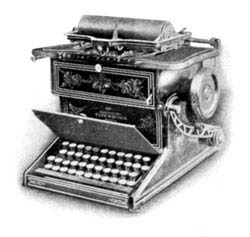
The typewriter will develop via Teletype machine(20) to a keyboard: a flat box of just an few centimeters high with keys in the same order (QWERTY) as the old typewriter(21). Until far into the 21st century that will remain the most used way to enter data into computers.
![]() Feb 17, Thomas J. Watson Sr. (d.1956), U.S. industrialist, is
born in upstate New York. In 1914 he will begin running the Computing-Tabulating-Recording
Co., a predecessor to IBM. He will transform the financially ailing manufacturing
business into the international giant IBM.(3)
Feb 17, Thomas J. Watson Sr. (d.1956), U.S. industrialist, is
born in upstate New York. In 1914 he will begin running the Computing-Tabulating-Recording
Co., a predecessor to IBM. He will transform the financially ailing manufacturing
business into the international giant IBM.(3)
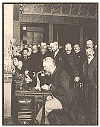
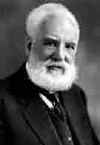
![]() Alexander Graham Bell(USA) invents
the telephone. At right you see Mr. Bell demonstrating
his invention to the Academy of Sciences.
Alexander Graham Bell(USA) invents
the telephone. At right you see Mr. Bell demonstrating
his invention to the Academy of Sciences.
The age of telecommunication started via telephone wires. To select a number was a matter of turning a handle. This activated an induction coil to generate power to ring a bell. It rang a bell at everybody's home or room at the same time. Seen below is the original setup Bell used and can be seen at the S.I. in Washington USA.
 (23)
(23)
It will take computers about a century to start using telephone lines.
![]() In this year Baron Kelvin built the
first analogue machine: the "Harmonic Analyzer". This machine predicted
the tides.(22)(25)
In this year Baron Kelvin built the
first analogue machine: the "Harmonic Analyzer". This machine predicted
the tides.(22)(25)
![]() Alexander Graham Bell's took two key patents on the telephone
in 1876 and 1877, these patents became the base of American Telephone and Telegraph
Company (AT&T) founded by Bell in Massachusetts in 1877. (26)
Alexander Graham Bell's took two key patents on the telephone
in 1876 and 1877, these patents became the base of American Telephone and Telegraph
Company (AT&T) founded by Bell in Massachusetts in 1877. (26)
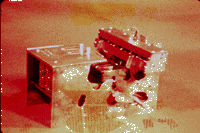
![]() In 1878, Ramon Verea, a Spaniard living
in New York, invents the first direct multiplying machine. 'Direct' means that
only one turn of the crank for each figure in the multiplier was needed to perform
the calculation, rather than the previously used repeated additions this is
much faster than the shifting carriage or other digital methods.
In 1878, Ramon Verea, a Spaniard living
in New York, invents the first direct multiplying machine. 'Direct' means that
only one turn of the crank for each figure in the multiplier was needed to perform
the calculation, rather than the previously used repeated additions this is
much faster than the shifting carriage or other digital methods.
Verea asserts that he did not make the machine to sell the patent or to put
it to use, but simply to show that it could be done and that a Spaniard can
invent as well as an American. The machine did not receive much publicity. 22b
![]() G. Frege was one of the founders of modern
symbolic languages. He proposed a system of notation that we now know as 'proposition
logic'. His method will be used extensively in knowledge systems in the field
of Artificial Intelligence from the late 1900's onwards.
G. Frege was one of the founders of modern
symbolic languages. He proposed a system of notation that we now know as 'proposition
logic'. His method will be used extensively in knowledge systems in the field
of Artificial Intelligence from the late 1900's onwards.

![]() Though Thomas Alva Edison (USA)
invented the first light bulb that could burn a long time. Though he did not
invent the lightbulb as commonly assumed it was however Edison who made the
first practical and commercial viable, but above all endurable, lightbulb. From
this light bulb the first vacuum tubes were evolved, these will be used in early
electronic computers. (ABC - Colossus - Mark I etc.)
Though Thomas Alva Edison (USA)
invented the first light bulb that could burn a long time. Though he did not
invent the lightbulb as commonly assumed it was however Edison who made the
first practical and commercial viable, but above all endurable, lightbulb. From
this light bulb the first vacuum tubes were evolved, these will be used in early
electronic computers. (ABC - Colossus - Mark I etc.)
![]() A committee investigates the feasibility of completing the Analytical
Engine and concludes that it is impossible now that Babbage is dead.(2)
A committee investigates the feasibility of completing the Analytical
Engine and concludes that it is impossible now that Babbage is dead.(2)
 22b
22b
![]()
![]() V.T. Odhner parts company with Nobel and
started his own company. In 1886 he began to manufacture the "Original
Odhner" in Russia. An adding machine with a rack-wheel with variable number
wheels. A later model called the Felix will be released in 1890. The Odhner
machine sells very well all over Europe and sold until the first three or four
decades of the 20th century.(4) However, patent rights for
Germany had been bought by another firm, Grimme
Natalis, which improved the patents and placed a similar machine on the market.
22b
V.T. Odhner parts company with Nobel and
started his own company. In 1886 he began to manufacture the "Original
Odhner" in Russia. An adding machine with a rack-wheel with variable number
wheels. A later model called the Felix will be released in 1890. The Odhner
machine sells very well all over Europe and sold until the first three or four
decades of the 20th century.(4) However, patent rights for
Germany had been bought by another firm, Grimme
Natalis, which improved the patents and placed a similar machine on the market.
22b
K. Hattori Co. Ltd was founded, in 1892 it name is changed into Seikosha Co.
Ltd. And in 1985 the name was again changed. Now into SEIKO EPSON Corp., Epson
stands for Son of Electronic Printer. (1)
American Thomas Edison discovers the Edison effect, in which a electric current flows through a vacuum.
![]() Herman
Hollerith (USA) applied for his patent on the punched card. It is a card
with 45 evenly spread holes in rows of 5 by 9. Each hole can be given a special
meaning.
Herman
Hollerith (USA) applied for his patent on the punched card. It is a card
with 45 evenly spread holes in rows of 5 by 9. Each hole can be given a special
meaning.
Example: Initially such a card does not have holes (a blank card). We could
say that if there is a hole on row number 3 position 4, the subject is
married. If there is a hole on position 5,2 the subject belongs to a group that
is younger than 45 but older than 40.
This example is taken on purpose, because the first non-experimental use of
the punched card system will be used by the census bureau of the USA a few years
later.

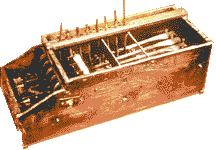
![]() Dorr E. Felt, a 24-year-old machinist finally found the
answer to the problem that calculators were overshooting their maximum number
range and thus jamming or giving wrong answers.
Dorr E. Felt, a 24-year-old machinist finally found the
answer to the problem that calculators were overshooting their maximum number
range and thus jamming or giving wrong answers.
He chose Thanksgiving Day, 1884 to start the project.
Felt had solved the over-rotation problem by providing positive stops that were
activated by the keys themselves. He knew his machines had to calculate faster
than accountants, many of whom could mentally add four columns of figures at
one time.22b For years, Eugene Felt kept his original
hand-made model on his desk at the Comptometer factory as a reminder of the
company's humble beginning. Today the prototype can be seen at the Smithsonian
Institution in Washington, D.C.(5)
![]() The IEE (Institute of Electrical Engeneers) was founded. One
of the societies that will greatly stimulate the development of Electrical Engineering(1)
The IEE (Institute of Electrical Engeneers) was founded. One
of the societies that will greatly stimulate the development of Electrical Engineering(1)
![]() John Henry Paterson founds his company to produce cash registers
it was named: NCR (National Cash
Register).
John Henry Paterson founds his company to produce cash registers
it was named: NCR (National Cash
Register).

![]() First variable toothed gear calculator Frank Baldwin (USA) and
W T Odhner (Sweden) A multiplying calculator more compact than the Arithmometer
enters mass production (2)
First variable toothed gear calculator Frank Baldwin (USA) and
W T Odhner (Sweden) A multiplying calculator more compact than the Arithmometer
enters mass production (2)
![]() First printing adding machine. William Burroughs patents an
adding machine that prints lists of added numbers.(2)
First printing adding machine. William Burroughs patents an
adding machine that prints lists of added numbers.(2)
| Last Updated on June 22, 2004 | For suggestions please mail the editors |
Footnote and References